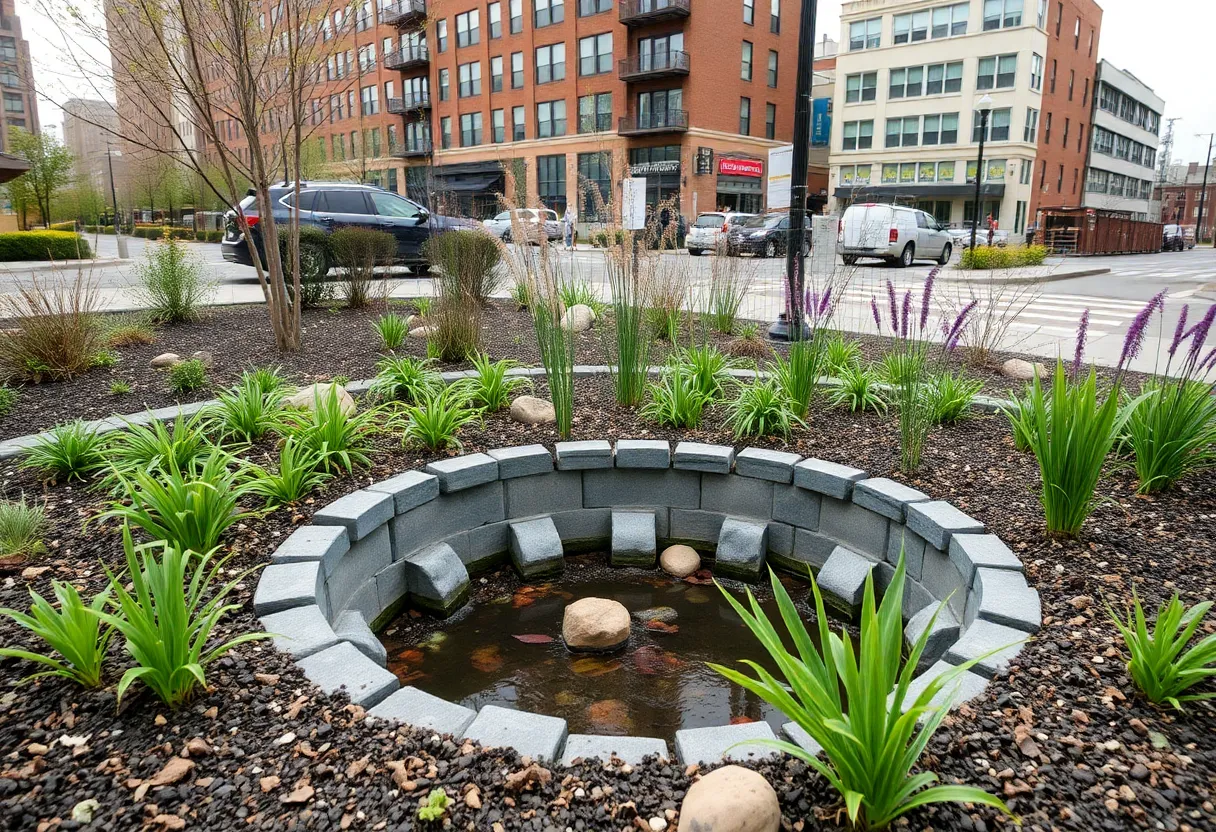Designing a Rain Garden in Philadelphia: An Effective Strategy for Stormwater Management and Environmental Enhancement
Introduction
Philadelphia faces ongoing challenges related to stormwater runoff, pollution, and urban flooding. Implementing rain gardens offers a sustainable solution that addresses these issues while providing ecological, aesthetic, and infrastructural benefits. A rain garden is a carefully designed landscape feature that captures, infiltrates, and filters stormwater, reducing its impact on city sewer systems and local waterways.
Understanding Rain Gardens
What is a Rain Garden?
A rain garden is a shallow, bowl-shaped depression typically landscaped with native plants. Its primary purpose is to capture runoff from impervious surfaces such as roofs, driveways, and sidewalks. Unlike traditional lawns, rain gardens are engineered to hold and absorb water temporarily, channeling it into the soil rather than directly into storm drains.
This process facilitates pollutant filtration, encourages groundwater recharge, and minimizes urban flooding. Usually, they are designed to blend seamlessly into existing landscapes, providing both functional and visual benefits.
How Do Rain Gardens Work?
When stormwater flows onto impervious surfaces, it naturally proceeds toward low-lying areas. Rain gardens intercept this flow, causing water to pond briefly before percolating into the soil through the garden’s planting medium. The native vegetation plays a vital role by absorbing water, taking up nutrients, and filtering out pollutants such as sediments, oils, and chemicals. The process reduces overwhelming pressure on city sewer systems, especially during heavy rainfall.
Core Benefits of Rain Gardens
Pollution Control
Rain gardens filter pollutants by trapping sediments and absorbing harmful substances before they reach waterways. This natural filtration enhances water quality in local streams, rivers, and lakes.
Flood Mitigation
By capturing and delaying runoff, rain gardens diminish the volume and velocity of stormwater entering drainage systems. This decreases localized flooding risk during intense storm events.
Groundwater Recharge
Properly designed rain gardens promote infiltration, helping to replenish underground aquifers. This supports a sustainable water cycle and maintains the health of natural ecosystems.
Supporting Local Wildlife
Native plants used in rain gardens provide essential habitat and food for local wildlife—including insects, birds, and pollinators—thus bolstering urban biodiversity.
Aesthetic and Property Value Enhancement
Beyond their functional benefits, rain gardens add visual appeal. They introduce diverse textures, colors, and seasonal interest, elevating property aesthetics and potentially increasing real estate value.
Designing a Rain Garden in Philadelphia
1. Site Selection
Location
An effective rain garden should be situated to intercept runoff from impervious surfaces such as roofs, patios, and driveways. It should be at least 10 feet away from building foundations and property lines to avoid water interference with structures and neighbors.
Topography
Select a natural low point with a gentle slope that directs water toward the garden. A site with existing drainage tendencies simplifies design and enhances functionality.
Soil Permeability Testing
Conduct a percolation test by digging a 6-inch-deep hole, filling it with water, and measuring drainage time. Ideally, the rate should be between 0.5 to 8 inches per hour. Rates slower than this suggest the need for soil amendments or alternate locations.
2. Sizing the Rain Garden
Calculating Dimensions
The size of the rain garden should be approximately 20-30% of the area of the impervious surface draining into it. For example, a 1,000-square-foot roof would correspond to a garden between 200 and 300 square feet. This ensures adequate capacity for stormwater management.
Determining Depth
Typical depths range from 4 to 9 inches, adjusted based on soil infiltration rates. Shallow gardens are easier to maintain and integrate into residential landscapes.
3. Excavation and Soil Preparation
Digging the Basin
Excavate the designated area to the calculated size and depth, creating a shallow depression. The sides should gently slope to prevent erosion and facilitate plant establishment.
Soil Amendment
Loosen the bottom soil to about 12 inches and mix in organic materials such as compost to improve drainage and nutrient content, ensuring plants thrive and the garden functions effectively.
4. Plant Selection
Native Plants
Prioritize native species adapted to Philadelphia’s climate, including grasses, perennials, and shrubs. Native plants support local pollinators and require less water and maintenance.
Layering Plants
Design plant zones with water-tolerant species in the garden’s center, where accumulation occurs, and drought-tolerant species at the edges. Incorporate diversity to enhance resilience and visual interest throughout the year.
5. Installation and Finishing
Planting
Arrange plants according to their specific needs—matching sunlight exposure and moisture requirements. Proper spacing facilitates growth and ensures the garden’s longevity.
Mulching
Apply a 2-3 inch layer of organic mulch over the planting area to conserve moisture, suppress weeds, and protect roots during temperature fluctuations.
Watering and Establishment
Thoroughly water newly planted greenery and maintain consistent watering during the first growing season to ensure root establishment and vitality.
6. Maintenance Guidelines
- Weeding: Regularly remove invasive and competing weeds to maintain plant health.
- Inspection: After heavy rains, verify that water infiltrates properly. Adjust plant spacing or add mulch if necessary.
- Seasonal Care: Leave seed heads in autumn to support wildlife and leave some dead stems for winter structure.
Resources and Support for Philadelphia Residents
The city’s water authority offers multiple programs to facilitate rain garden adoption:
- Financial Assistance: Grants and rebates may offset costs associated with installation, including materials and plants.
- Educational Workshops: Training sessions inform residents about stormwater management best practices and plant selection.
- Technical Assistance: Expert guidance supports site assessment, design, and ongoing maintenance.
Conclusion
Implementing a rain garden in Philadelphia transforms stormwater challenges into opportunities for sustainable landscape enhancement. When properly designed and maintained, rain gardens effectively retain and filter stormwater, reduce urban flooding, support local ecosystems, and boost neighborhood aesthetics. Awareness of site-specific conditions, native plant selection, and community resources ensures successful, long-term benefits, contributing positively to urban resilience and environmental health.
Frequently Asked Questions
| Question | Answer |
|---|---|
| What is the ideal location for a rain garden? | It should be placed where runoff from impervious surfaces collects, at least 10 feet from structures, and on a gently sloping area that directs water into the garden. |
| How deep should a rain garden be? | Typically between 4 to 9 inches, depending on soil infiltration rates and the volume of runoff it needs to handle. |
| Are native plants necessary for rain gardens? | No, but native plants are recommended because they are better adapted to local conditions, support pollinators, and require less maintenance. |
| How often should I maintain my rain garden? | Regularly check for weeds, inspect after storms to ensure proper infiltration, and perform seasonal upkeep such as mulching and deadheading plants. |
| Can I install a rain garden on any property in Philadelphia? | Most properties can accommodate a rain garden with proper planning. Site conditions, soil permeability, and available space are key considerations. |
FAQ Schema (JSON-LD Format)
Key Features of Effective Rain Garden Design
| Feature | Details |
|---|---|
| Location | Near runoff sources, away from foundations, on gentle slopes |
| Size | 20-30% of contributing impervious area, adjusted by local conditions |
| Depth | 4 to 9 inches based on soil permeability |
| Plant Selection | Native, layered (water-loving to drought-tolerant), diverse |
| Soil | Amended with organic matter for optimal infiltration |
| Maintenance | Weeding, inspection, seasonal care, mulching |
| Community Support | Educational programs, incentives, technical assistance |
Author: STAFF HERE PHILADELPHIA WRITER
The PHILADELPHIA STAFF WRITER represents the experienced team at HEREPhiladelphia.com, your go-to source for actionable local news and information in Philadelphia, Philadelphia County, and beyond. Specializing in "news you can use," we cover essential topics like product reviews for personal and business needs, local business directories, politics, real estate trends, neighborhood insights, and state news affecting the area—with deep expertise drawn from years of dedicated reporting and strong community input, including local press releases and business updates. We deliver top reporting on high-value events such as Mummers Parade, Philadelphia Flower Show, and Thanksgiving Day Parade. Our coverage extends to key organizations like the Greater Philadelphia Chamber of Commerce and United Way of Greater Philadelphia, plus leading businesses in telecommunications, food services, and healthcare that power the local economy such as Comcast, Aramark, and Children's Hospital of Philadelphia. As part of the broader HERE network, we provide comprehensive, credible insights into Pennsylvania's dynamic landscape.





